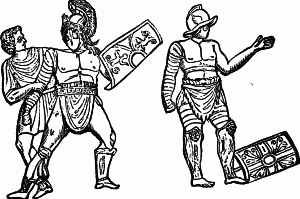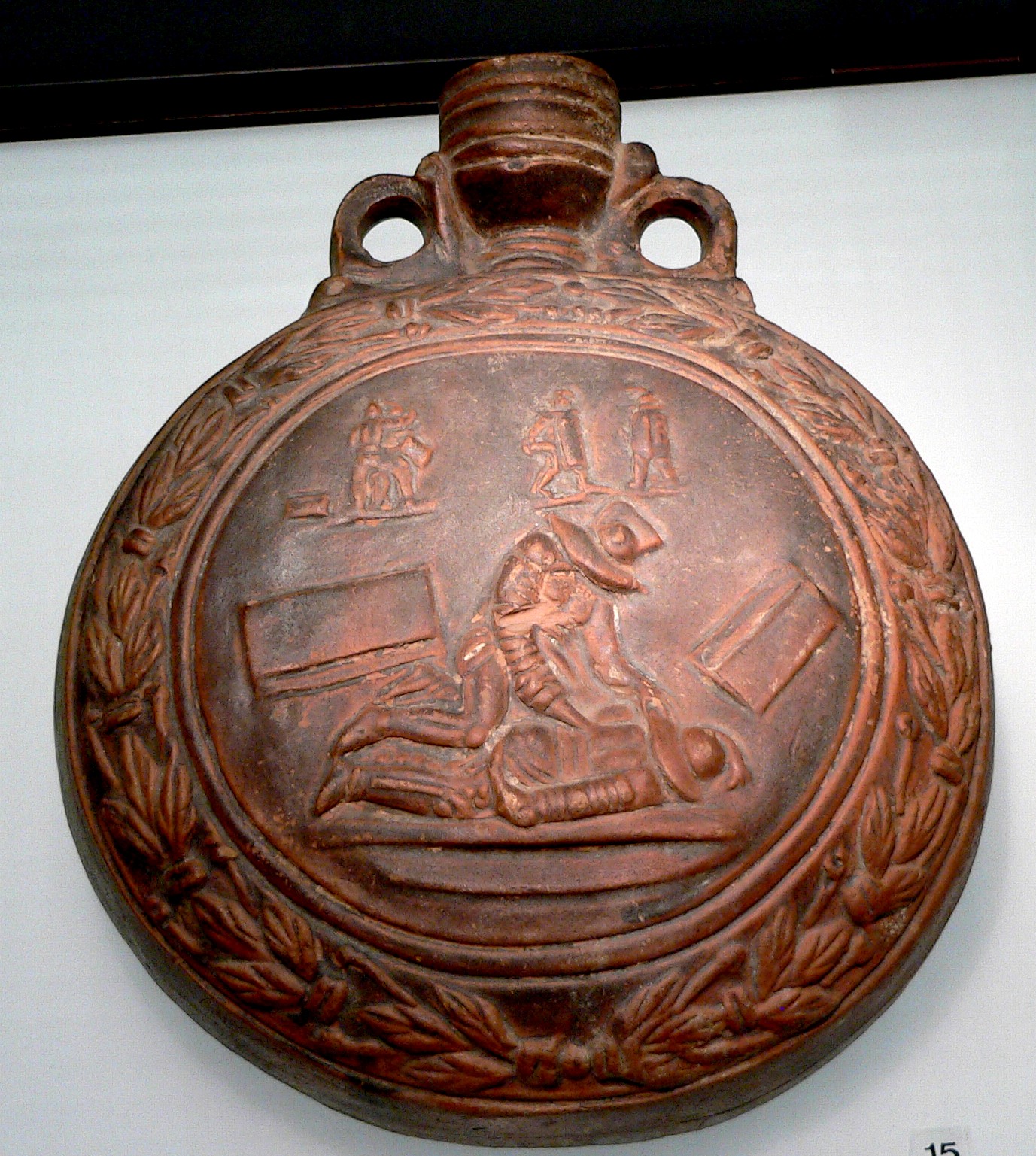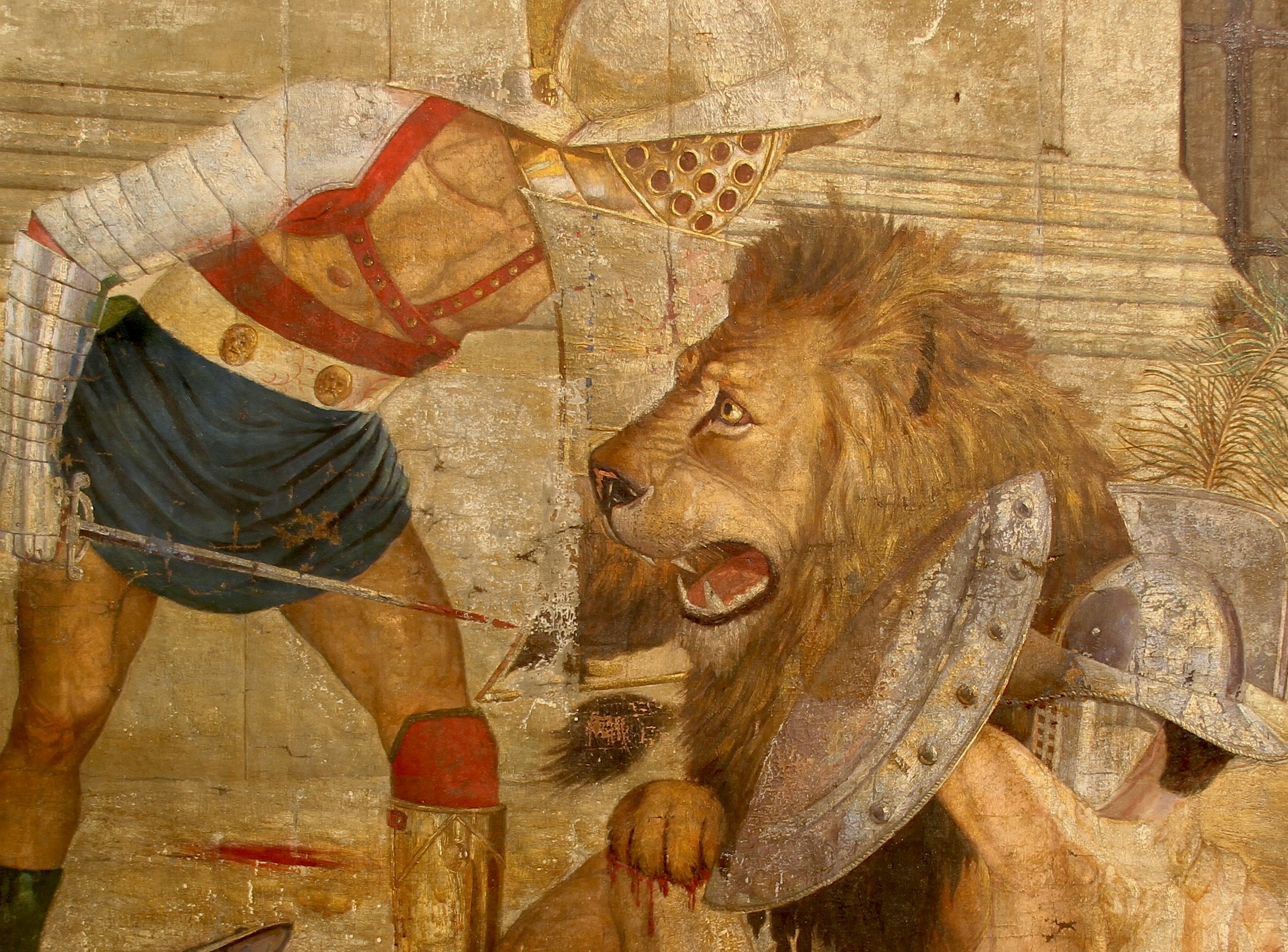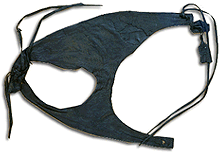|
Hoplomachus
A hoplomachus (pl. hoplomachi) (hoplon meaning "equipment" in Greek) was a type of gladiator in ancient Rome, armed to resemble a Greek hoplite (soldier with heavy armor and helmet, a small, round, concave shield, a spear and a sword). The hoplomachus would wear a bronze helmet, a manica on his right arm, loincloth (''subligaculum''), heavy padding on his legs, and a pair of high greaves reaching to mid-thigh. His weapons were the spear and a short sword. He was often pitted against the murmillo (armed like a Roman soldier), perhaps as a re-enactment of Rome's wars in Greece and the Hellenistic East. The name hoplomachus means 'armored fighter'. The small, round shield was as much a weapon as a sword or spear, not unlike the original hoplites (who carried a larger shield), who used it primarily for defensive purposes, but also employed it in their charges, using it to ram their opponents at the onset of a fight. They wore no shoes so the sand would chafe their feet, presenting ... [...More Info...] [...Related Items...] OR: [Wikipedia] [Google] [Baidu] |
List Of Roman Gladiator Types
There were many different types of gladiators in ancient Rome. Some of the first gladiators had been prisoners-of-war, and so some of the earliest types of gladiators were experienced fighters; Gauls, Samnites, and ''Thraeces'' (Thracians) used their native weapons and armor. Different gladiator types specialized in specific weapons and fighting techniques. Combatants were usually pitted against opponents with different, but more or less equivalent equipment, for the sake of a fair and balanced contest. Most gladiators only fought others from within the same school or ''ludus'', but sometimes specific gladiators could be requested to fight one from another ''ludus''. Elite gladiators wore high-quality decorative armour for the pre-game parade ''(Pompa)''. Julius Caesar's gladiators wore silver armour, Domitian's wore golden armour and Nero's wore armour decorated with carved amber. Peacock feathers were used for plumes while tunics and loincloths had patterns in gold thread. For t ... [...More Info...] [...Related Items...] OR: [Wikipedia] [Google] [Baidu] |
Samnite (gladiator Type)
A Samnite (Latin ''Samnis'', plural ''Samnites'') was a Roman gladiator who fought with equipment styled on that of a warrior from Samnium: a short sword (''gladius''), a rectangular shield (''scutum''), a greave (ocrea), and the helmet. Warriors armed in such a way were the earliest gladiators in the Roman games. They appeared in Rome shortly after the defeat of Samnium in the 4th century BC, apparently adopted from the victory celebrations of Rome's allies in Campania. By arming low-status gladiators in the manner of a defeated foe, Romans mocked the Samnites and appropriated martial elements of their culture. Samnites were quite popular during the period of Roman Republic. Eventually, other gladiator types joined the roster, such as the murmillo and the Thraex. Under the reign of Emperor Augustus, Samnium became an ally and integral part of the Roman Empire (all Italians had by this point gained Roman citizenship). The Samnite was replaced by similarly armed gladiators, inclu ... [...More Info...] [...Related Items...] OR: [Wikipedia] [Google] [Baidu] |
Murmillo
The murmillo (also sometimes spelled "mirmillo" or "myrmillo", pl. murmillones) was a type of gladiator during the Roman Imperial age. The murmillo-class gladiator was adopted in the early Imperial period to replace the earlier Gallus, named after the warriors of Gaul. As the Gauls inhabiting Italy had become well integrated with the Romans by the time of the reign of Augustus, it became undesirable to portray them as enemy outsiders; the Gallus-class gladiator thus had to be retired. Equipment and armaments The murmillo was armed with: *Gladius: Roman sword with a length of 64–81 cm and weight of 1.2-1.6 kg with a handle made of bone. *Scutum: Rectangular shield made of vertically connected wooden boards with a small bronze boss which protects the shield's handle. * Balteus: Leather belt with metal decorations and supplements. Similar to current boxing belts. * Manica: Segmented or scaled arm guard made of leather or some metal alloys. Manicae can also be mail ... [...More Info...] [...Related Items...] OR: [Wikipedia] [Google] [Baidu] |
Murmillo
The murmillo (also sometimes spelled "mirmillo" or "myrmillo", pl. murmillones) was a type of gladiator during the Roman Imperial age. The murmillo-class gladiator was adopted in the early Imperial period to replace the earlier Gallus, named after the warriors of Gaul. As the Gauls inhabiting Italy had become well integrated with the Romans by the time of the reign of Augustus, it became undesirable to portray them as enemy outsiders; the Gallus-class gladiator thus had to be retired. Equipment and armaments The murmillo was armed with: *Gladius: Roman sword with a length of 64–81 cm and weight of 1.2-1.6 kg with a handle made of bone. *Scutum: Rectangular shield made of vertically connected wooden boards with a small bronze boss which protects the shield's handle. * Balteus: Leather belt with metal decorations and supplements. Similar to current boxing belts. * Manica: Segmented or scaled arm guard made of leather or some metal alloys. Manicae can also be mail ... [...More Info...] [...Related Items...] OR: [Wikipedia] [Google] [Baidu] |
Gladiator
A gladiator ( la, gladiator, "swordsman", from , "sword") was an armed combatant who entertained audiences in the Roman Republic and Roman Empire in violent confrontations with other gladiators, wild animals, and condemned criminals. Some gladiators were volunteers who risked their lives and their legal and social standing by appearing in the arena. Most were despised as slaves, schooled under harsh conditions, socially marginalized, and segregated even in death. Irrespective of their origin, gladiators offered spectators an example of Rome's martial ethics and, in fighting or dying well, they could inspire admiration and popular acclaim. They were celebrated in high and low art, and their value as entertainers was commemorated in precious and commonplace objects throughout the Roman world. The origin of gladiatorial combat is open to debate. There is evidence of it in funeral rites during the Punic Wars of the 3rd century BC, and thereafter it rapidly became an essential fea ... [...More Info...] [...Related Items...] OR: [Wikipedia] [Google] [Baidu] |
Thraex
The Thraex (pl. Thraeces), or Thracian, was a type of Roman gladiator, armed in the Thracian style with a small rectangular, square or circular shield called a '' parmula'' (about 60 x 65 cm) and a very short sword with a slightly curved blade called a ''sica'' (like a small version of the Dacian falx), intended to maim an opponent's unarmoured back. His other armour included armoured greaves, a protective belt above a loincloth, and a helmet with a side plume, visor and high crest. Ludia's female gladiators used the same weapons and armour. He and the hoplomachus, with his Greek equipment, were usually pitted against the murmillo, armed like a legionary, mimicking the opposition between Roman soldiers and their various slaves. In essence, these slaves were not trained well and died a gruesome death. See also * Ludus Dacicus * List of Roman gladiator types There were many different types of gladiators in ancient Rome. Some of the first gladiators had been prisoners-of- ... [...More Info...] [...Related Items...] OR: [Wikipedia] [Google] [Baidu] |
Thraex
The Thraex (pl. Thraeces), or Thracian, was a type of Roman gladiator, armed in the Thracian style with a small rectangular, square or circular shield called a '' parmula'' (about 60 x 65 cm) and a very short sword with a slightly curved blade called a ''sica'' (like a small version of the Dacian falx), intended to maim an opponent's unarmoured back. His other armour included armoured greaves, a protective belt above a loincloth, and a helmet with a side plume, visor and high crest. Ludia's female gladiators used the same weapons and armour. He and the hoplomachus, with his Greek equipment, were usually pitted against the murmillo, armed like a legionary, mimicking the opposition between Roman soldiers and their various slaves. In essence, these slaves were not trained well and died a gruesome death. See also * Ludus Dacicus * List of Roman gladiator types There were many different types of gladiators in ancient Rome. Some of the first gladiators had been prisoners-of- ... [...More Info...] [...Related Items...] OR: [Wikipedia] [Google] [Baidu] |
Dimachaeri
The dimachaeri (singular: dimachaerus) were a type of Roman gladiator that fought with two swords. The name is the Latin-language borrowing of the Greek word meaning "bearing two knives" ( di- ''dual'' + machairi ''knife''). The dimachaeri were popular during the 2nd-4th centuries AD, and were probably considered to be "insidious" by many Romans. Both written and pictorial records on dimachaeri are scant and rather indeterminate. Thus, an inscription from Lyon, France, mentions such a type of gladiator, here spelled ''dymacherus''. Equipment Depictions of Himachali and their equipment vary in pictorial sources, so it is difficult to say exactly how, and how uniformly, they were equipped. Some pictorial sources depict wearing extremely minimal such as a balteus and leather wrappings or none at all, save a ''subligaculum'' (loin cloth). Other show a slightly more heavily armored dimachaerus, variously equipped with scale armor, mail shirts, visored helmets in the fashion of mur ... [...More Info...] [...Related Items...] OR: [Wikipedia] [Google] [Baidu] |
Ancient Rome
In modern historiography, ancient Rome refers to Roman civilisation from the founding of the city of Rome in the 8th century BC to the collapse of the Western Roman Empire in the 5th century AD. It encompasses the Roman Kingdom (753–509 BC), Roman Republic (509–27 BC) and Roman Empire (27 BC–476 AD) until the fall of the western empire. Ancient Rome began as an Italic settlement, traditionally dated to 753 BC, beside the River Tiber in the Italian Peninsula. The settlement grew into the city and polity of Rome, and came to control its neighbours through a combination of treaties and military strength. It eventually dominated the Italian Peninsula, assimilated the Greek culture of southern Italy ( Magna Grecia) and the Etruscan culture and acquired an Empire that took in much of Europe and the lands and peoples surrounding the Mediterranean Sea. It was among the largest empires in the ancient world, with an estimated 50 to 90 million inhabitants, roughly 20% of t ... [...More Info...] [...Related Items...] OR: [Wikipedia] [Google] [Baidu] |
Hoplite
Hoplites ( ) ( grc, ὁπλίτης : hoplítēs) were citizen-soldiers of Ancient Greece, Ancient Greek Polis, city-states who were primarily armed with spears and shields. Hoplite soldiers used the phalanx formation to be effective in war with fewer soldiers. The formation discouraged the soldiers from acting alone, for this would compromise the formation and minimize its strengths. The hoplites were primarily represented by free citizens – propertied farmers and artisans – who were able to afford a Linothorax, linen armour or a bronze armour suit and weapons (estimated at a third to a half of its able-bodied adult male population). Most hoplites were not professional soldiers and often lacked sufficient military training. Some states maintained a small elite professional unit, known as the ''wikt:επιλέγω, epilektoi'' ("chosen") since they were picked from the regular citizen infantry. These existed at times in Athens, Argos, Peloponnese, Argos, Thebes, Greec ... [...More Info...] [...Related Items...] OR: [Wikipedia] [Google] [Baidu] |
Manica (armguard)
A manica ( la, manica , "sleeve") or cheires by the Greeks was a type of iron or bronze arm guard, with curved and overlapping metal segments or plates, fastened to leather straps, worn by Roman gladiators called crupellarii, and later optionally by soldiers. History and usage As early as Achaemenid times, there were references to "cheires" (χειρίς) which consisted of hoops of metal that would be worn on the rein arm of a cavalryman. Hooped armour became extremely popular to use on both arms and legs in the Saka, Parthian, and Kushan kingdoms. They can be seen at Khalchayan and on many pieces of Parthian artwork. Roman troops fought crupellarii in the revolt of Florus and Sacrovir of AD 21. It is unclear how widely the manica was used in Trajan's Dacian Wars. Manicae (along with metal greaves) are attested as a supplement to metal body armor on several reliefs depicting that campaign, including the Tropaeum Traiani at Adamclisi and Trajan's Column. Trajan's column ... [...More Info...] [...Related Items...] OR: [Wikipedia] [Google] [Baidu] |
Subligaculum
A ''subligaculum'' was a kind of undergarment worn by ancient Romans. It could come either in the form of a pair of shorts, or in the form of a simple loincloth wrapped around the lower body. It could be worn both by men and women. In particular, it was part of the dress of gladiators, athletes, and of actors on the stage. Leather ''subligacula'' have been found in excavations of 1st century Roman London. The longer-form ''subligaculum'' that forms a loin cloth is tied as follows: First, the strings are tied around the waist with the long part hanging down back, covering the buttocks. Next, the long part is brought down between the legs and pulled up behind the knot tied in front. Then it is draped over the ties so it forms a loincloth. See also * Kacchera * Kaupinam * Dhoti * Lungi * Breechcloth * Fundoshi * Loincloth * Mawashi * Perizoma * Thong * Tallit katan * Temple garment A temple garment, also referred to as garments, the garment of the holy priesthood, or Mormon unde ... [...More Info...] [...Related Items...] OR: [Wikipedia] [Google] [Baidu] |







